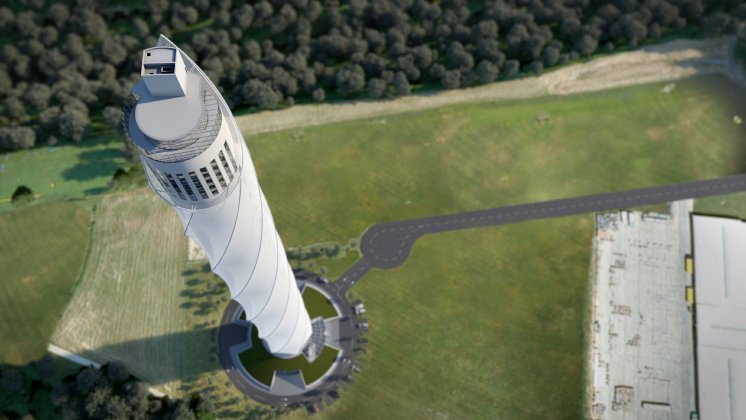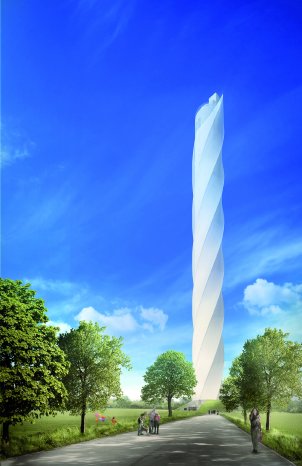The installation at the 246 meter-high tower presents the entire planning team with unique challenges. Only specially trained technicians who are certified to do installations at these heights are employed for the membrane assembly. Using two mobile platforms, they measure the exterior and attach spacers and pipes to mount the membrane. Separately, the façade will be assembled in three parts and installed from top to bottom. Due to the gradual gradation of the membrane, the tower will appear almost opaque at the bottom and become more transparent toward the top, where the fabric is wide-meshed.
The 17,000 square meter membrane is made of PTFE-glass, which is used for the first time in this form. The fabric is produced in strips of three meters, which are later welded to form bigger membrane sections. The polymer-coated glass fiber fabric is a highly complex material that is long-lasting, almost self-cleaning and in addition to giving the tower its distinctive appearance, will also protect it from intense solar radiation and reduce building movement by combating wind forces. It has been extensively tested in a wind tunnel and certified by an independent expert body.
For the 29-member planning team of Taiyo Europe, responsible for manufacturing and assembling the membrane, the test tower is special in all respects: “The planning phase as well as the assembly meant new challenges for us, because the requirements and specifications are entirely unique. We from Taiyo Europe are proud to participate in this singular project,” says Hubert Reiter, managing director of Taiyo Europe.
“We are delighted that with the installation of the outer membrane, construction work on the tower is approaching completion,” said Dr. Christian Ruf, Mayor of Rottweil. The work of experts from Taiyo Europe, who have provided textile architecture for renowned projects such as the Millennium Dome in London, San Francisco Airport, the German Pavilion at Expo Milan and the Mercedes-Benz-Arena in Stuttgart, is attracting great public interest in Rottweil. “Locals as well as numerous tourists who have been visiting Rottweil since the construction of the tower began can hardly wait to see the final look of our new landmark.”
Since the construction work is on schedule, the research operations at the tower are slated to begin in December 2016. In May 2017, the tower will also be opened to visitors. “For thyssenkrupp Elevator, the test tower in Rottweil will play a key role in the implementation of our global innovation strategy, which is crucial for the company’s success,” says Andreas Schierenbeck, CEO of thyssenkrupp Elevator. Together with the elevator plant in Neuhausen auf den Fildern, and as part of the company’s global Research & Development network, the tower marks the area as an innovation center for elevator technology in Germany. Here, innovative mobility solutions of the future will be explored, developed, and tested, in order to make cities the best ever places to live.
Together with general contractor Züblin, thyssenkrupp began building the elevator test tower in 2014. Technologies that will be tested here include the MULTI, with three of the tower’s twelve shafts reserved for the new elevator system. Powered by maglev technology from the Transrapid, the MULTI offers a number of advantages: the rope-free design allows several cabins to operate in a single shaft, increasing passenger capacity per shaft by up to 50 percent and at the same time reducing the elevator footprint in a building by half. Additionally, the elevators can move both sideways and vertically without height limitations, opening up completely new applications and unprecedented architectural possibilities.




